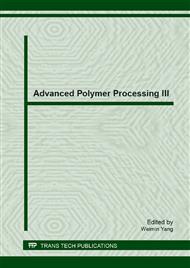[1]
J. Raasch, Beauspruchung und Verhalten Suspendieru Feststoffeilchen in Scherstro-mungen hoher Festigker, first ed., TH Karlsruhe, Germany, 1961.
Google Scholar
[2]
G. Martin, Uniterschung der homogenizer-funktion von Einschneckenextrudern fur die Kunststoffver-arbeitung, first ed., Universitat Karlsruhe, Germany, 1972.
Google Scholar
[3]
G. Lidor, Z. Tadmor, Theoretical analysis of residence time distribution functions and strain distribution functions in plasticating screw extruders, Polym. Eng. Sci. 16 (1975) 450-462.
DOI: 10.1002/pen.760160610
Google Scholar
[4]
Z. Tadmor, Mixing and residence time distribution in melt screw extruders, Polym. Eng. Sci. 10 (1970) 279-288.
DOI: 10.1002/pen.760100505
Google Scholar
[5]
I. Mans-Zloczower, A. Nir, Z. Tadmor, Dispersive mixing in internal mixers. A theoretical model based on agglomerate rupture, Rubber Chem. Technol. 55 (1982) 1250-1285.
DOI: 10.5254/1.3535929
Google Scholar
[6]
H. Potente, K. Kretschmer, J. Flecke, A physical-mathematical model for the dispersion process in continuous mixers, Polym. Eng. Sci. 42 (2002) 19-32.
DOI: 10.1002/pen.10925
Google Scholar
[7]
T. Ishikawa, T. Amano, S. Kihara, et al., Flow patterns and mixing mechanisms in the screw mixing element of a co-rotating twin-screw extruder, Polym. Eng. Sci. 42(2002) 925-939.
DOI: 10.1002/pen.11002
Google Scholar
[8]
V. L. Bravo, A. N. Hrymak, and J. D. Wright, Study of particle trajectories, residence times and flow behavior in kneading discs of intermeshing co-rotating twin-screw extruders, Polym. Eng. Sci. 44 (2004) 779-793.
DOI: 10.1002/pen.20070
Google Scholar
[9]
X. M. Zhang, L. F. Feng, W. X. Chen, G. H. Hu, Numerical simulation and experimental validation of mixing performance of kneading discs in a twin screw extruder, Polym, Eng. Sci. 49 (2009) 1772-1783.
DOI: 10.1002/pen.21404
Google Scholar
[10]
N. Yasuya, T. Eiji, S. Takashi, et al., Melt-mixing by novel pitched-tip kneading disks in a co-rotating twin-screw extruder, Chem. Eng. Sci. 66 (2011) 103-110.
DOI: 10.1016/j.ces.2010.10.022
Google Scholar
[11]
F. Ilinca, J. F. Hetu, Three-dimensional Numerical Study of the Mixing Behaviour of Twi-screw Elements, Int. Polym. Proc. 27 (2012) 111-120.
DOI: 10.3139/217.2450
Google Scholar
[12]
B. Alsteens, V. Legat, Numerical simulation for an open channel flow of a weakly elastic PIB solution around a T–profile, Proc 6th European Conf., Erlangen (Germany), September, (2002).
Google Scholar
[13]
Y. An. PhD, Study on the Mixing Properties and Preparation of Carbon Nanotubes/Epoxy Resin Composites of Continuous Mixer, Beijing University of chemical Technology, (2011).
Google Scholar
[14]
E. L. Canedo, L. N. Valsamis, Plastics compounding equipment and process, first ed., D. B. todd, Hansan, Munich, 1998.
Google Scholar
[15]
X. Z. Geng, Plastics mixing and continuous mixing equipment, first ed., China Light Industry Press, Beijing, China, 2008.
Google Scholar


